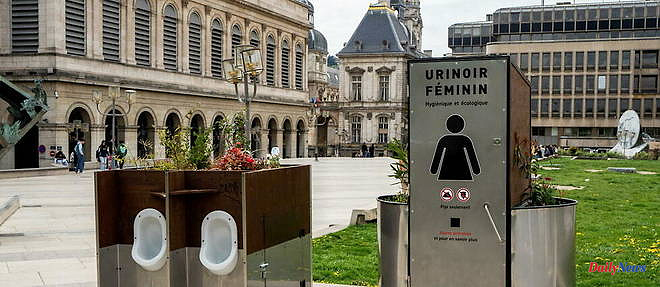Julien Damon is sometimes credited with a touch of madness. It suffices to be convinced of this by re-reading his columns in Le Point, published between 2016 and 2021: the sociologist and essayist proposed, for example, to "privatize the universities", to "degender the game of chess" or even "to register the UNESCO heritage kebab". We are in 2023, and it seems that Julien Damon maintains an intact appetite for offbeat ideas. The latest: a book published by Presses de Sciences Po simply titled Public Toilets. Essay on urban conveniences.
At first glance, the subject provokes laughter or revulsion. In the West, writes Julien Damon, "we loathe what we excrete". It is true that many taboos persist about toilets. And yet, going to the little corner is something of a confusing banality, as the author reminds us, from the first pages. At a rate of 4 to 5 daily visits, or ten minutes a day on average, we spend 0.7% of our lives in the toilet. In detail, and for the most curious, we dump one liter of urine and 200 grams of feces per day there. Over a lifetime of eighty years, a Frenchman releases a total of 30,000 liters and 6 tons.
Obviously, the interest of the book goes well beyond this type of anecdotes. Julien Damon provides real investigative work. "Caring about public restrooms is like caring about the world," he said. He draws a distressing conclusion: large cities, where the population density is high, lack toilets. Of course, we suspected that toilets were a health and humanitarian issue in poor countries. On the other hand, we were far from imagining that the situation of the rich Western metropolises was so unenviable. The professor at Sciences Po and HEC shows, without ever sinking into misery, that this situation exacerbates certain inequalities.
The case of homeless people is the most shameful for our affluent societies. Julien Damon, a leading specialist in urban issues and poverty, describes how they "tinker from a range of possibilities that range from the most unspeakable expedients to the most common practices". Thus, they often relieve themselves in the street, in parks, under porches or any other remote or dark corner. When they have the "luxury" of owning a tent, they then use a chamber pot, which they then empty where they can. They also mobilize all ranges of urban conveniences, from the famous sanisettes to open toilets in facilities open to the public...
The situation of mobility professionals also seems very unenviable. This is the case for bus drivers, taxis, VTCs, postmen, police cyclists, as well as the whole "new delivery service proletariat" (Uber Eats, Colissimo, etc.). In addition to the all-too-rare sanisettes, brasseries, cafes and fast-food outlets provide these workers with opportunities if they feel like it. They still have to be known and accepted, agree to consume, or be cunning enough not to be spotted. A galley…
Gender is also a source of inequality in the toilets. Admittedly, the supply of public toilets (libraries, town halls, museums, etc.) is equal in square meters of surface area. However, the queues in front of the toilets are much longer for women than for men. There are of course practical explanations. Apart from singular periods (menstruation, pregnancy, etc.), women must systematically sit or squat, which lengthens the transition time. “Overly egalitarian standards weigh on unequal physiologies and behaviors,” explains Julien Damon, who highlights several initiatives to rebalance the balance. For example, increasing the number of female urinals or enlarging the women's toilet space to the detriment of the men's.
Inequalities in access to the firm are especially striking between rich and developing countries. On the West side, the author devotes two chapters to the history of tremendous progress. From Roman collective latrines to "Rambuteau columns", from unhygienic "everything to the street" to "mains drainage", our northern societies come a long way. Today in France, 99.3% of households have a flush convenience seat. In 1946, 80% of homes had no indoor toilets!
Alas! in this decade of 2020, open defecation remains the daily life of more than 60% of the inhabitants of Niger, South Sudan and Chad, countries located in sub-Saharan Africa. This practice is also common in Central Asia and South Asia. In total, 6% of the inhabitants of the planet would be affected. Sometimes, even in the presence of "toilets", the daily life of the inhabitants of the South is not necessarily very enviable, for lack of a sanitation system. "The dirty or smelly toilets of the big slums of the South damage daily life and self-esteem", notes Julien Damon.
These six toilets could change the world: https://t.co/4ZXqwpQKxw
Fortunately, the progress in these parts of the globe, albeit insufficient, is unheard of! In 2000, 1.3 billion people were forced to defecate in the open, compared to 500 million today. India and China, two powers capable of sending satellites into space, have finally seized the bull by the horns. The UN pushed with all its weight to support the poorest countries. And philanthropists like Bill Gates, co-founder of Microsoft, have made it a hobbyhorse, even if it means letting themselves be photographed not in the saddle, but on a throne.
In addition to being a health issue, toilet equipment is an economic lever. In 2021, a McKinsey study for the NGO WaterAid highlighted tens of billions of possible savings in health care, time, and productivity that would come from access to water and sanitation. Often, we talk about a ratio of one dollar invested for five dollars returned. "If these cost-benefit estimates are debatable, they work politically, because they give an economically based basis to the expenditure", tempers Julien Damon.
However, the Western model cannot be applied as it is in developing countries. Firstly, because connection to the water and sanitation network is long and costly. But also because flush toilets are resource-intensive, which is incompatible with the environmental challenge of our century. The South must not only equip itself at low cost, but also invent the eco-friendly toilets of the future...
Let's go back to France. Julien Damon concludes his book with a series of proposals. The first is to enshrine a "right to toilets" in planning rules and in the law of local authorities. Concretely, communities would be set objectives, as there are for social housing. "Levels of coverage to be achieved could possibly be defined, such as x toilet places open to the public for x thousand people living in the neighborhood", suggests the sociologist.
Another idea is to subsidize cafes and restaurants so that they agree to open their toilets to everyone, not just customers. "The proposal amounts to developing a kind of public service delegation to these establishments", specifies Julien Damon. A not-so-crazy proposition...












